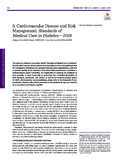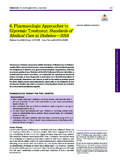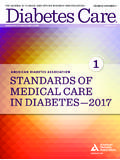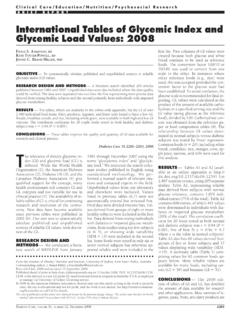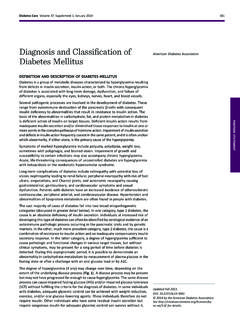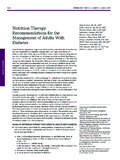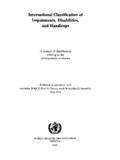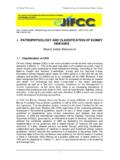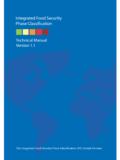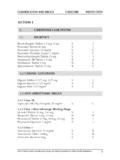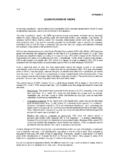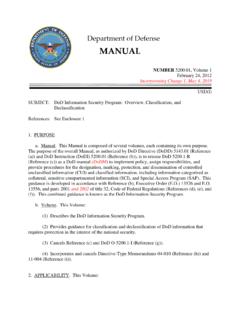Transcription of 2. Classification and Diagnosis of Diabetes
1 2. Classification and Diagnosisof DiabetesDiabetes Care 2017;40(Suppl. 1):S11 S24|DOI: can be classified into the following general categories:1. Type 1 Diabetes (due to autoimmuneb-cell destruction, usually leading to ab-solute insulin deficiency)2. Type 2 Diabetes (due to a progressive loss ofb-cell insulin secretion frequently onthe background of insulin resistance)3. Gestational Diabetes mellitus (GDM) ( Diabetes diagnosed in the second or thirdtrimester of pregnancy that was not clearly overt Diabetes prior to gestation)4. Specific types of Diabetes due to other causes, , monogenic Diabetes syn-dromes (such as neonatal Diabetes and maturity-onset Diabetes of the young[MODY]), diseases of the exocrine pancreas (such as cysticfibrosis), and drug- orchemical-induced Diabetes (such as with glucocorticoid use, in the treatment ofHIV/AIDS, or after organ transplantation)This section reviews most common forms of Diabetes but is not comprehensive.
2 Foradditional information, see the American Diabetes Association (ADA) position state-ment Diagnosis and Classification of Diabetes Mellitus (1).Type 1 Diabetes and type 2 Diabetes are heterogeneous diseases in which clinicalpresentation and disease progression may vary considerably. Classification is im-portant for determining therapy, but some individuals cannot be clearly classified ashaving type 1 or type 2 Diabetes at the time of Diagnosis . The traditional paradigmsof type 2 Diabetes occurring only in adults and type 1 Diabetes only in children are nolonger accurate, as both diseases occur in both cohorts.
3 Occasionally, patients withtype 2 Diabetes may present with diabetic ketoacidosis (DKA), particularly ethnicminorities (2). Children with type 1 Diabetes typically present with the hallmarksymptoms of polyuria/polydipsia, and approximately one-third present with DKA(3). The onset of type 1 Diabetes may be more variable in adults, and they may notpresent with the classic symptoms seen in children. Although difficulties in distin-guishing Diabetes type may occur in all age-groups at onset, the true diagnosisbecomes more obvious over October 2015, the ADA, JDRF, the European Association for the Study of Di-abetes, and the American Association of Clinical Endocrinologists convened theDifferentiation of Diabetes by Pathophysiology, Natural History, and Prognosis Re-search Symposium (4).
4 The goals of the symposium were to discuss the genetic andenvironmental determinants of type 1 and type 2 Diabetes risk and progression, todetermine appropriate therapeutic approaches based on disease pathophysiologyand stage, and to define research gaps hindering a personalized approach to treat-ment. The experts agreed that in both type 1 and type 2 Diabetes , various geneticand environmental factors can result in the progressive loss ofb-cell mass and/orfunction that manifests clinically as hyperglycemia. Once hyperglycemia occurs,patients with all forms of Diabetes are at risk for developing the same complications,although rates of progression may differ.
5 They concluded that the identification ofindividualized therapies for Diabetes in the future will require better characteriza-tion of the many paths tob-cell demise or of the underlying pathophysiology is much more developed intype 1 Diabetes than in type 2 Diabetes . It is now clear from studies offirst-degreerelatives of patients with type 1 Diabetes that the persistent presence of two orSuggested citation: American Diabetes Associa-tion. Classification and Diagnosis of 2. InStandards of Medical Care in Diabetesd2017. Diabetes Care 2017;40(Suppl. 1):S11 S24 2017 by the American Diabetes may use this article as long as the workis properly cited, the use is educational and notfor profit, and the work is not altered.
6 More infor-mation is available at Diabetes AssociationDiabetes CareVolume 40, Supplement 1, January 2017S112. Classification AND Diagnosis OF Diabetes more autoantibodies is an almost cer-tain predictor of clinical hyperglycemiaand Diabetes . The rate of progression isdependent on the age atfirst detectionof antibody, number of antibodies, anti-body specificity, and antibody titer. Glu-cose and A1C levels rise well before theclinical onset of Diabetes , making diag-nosis feasible well before the onset ofDKA. Three distinct stages of type 1 di-abetes can be identified (Table ) andserve as a framework for future researchand regulatory decision making (4,5).
7 The paths tob-cell demise and dys-function are less well definedintype2diabetes, but deficientb-cell insulin se-cretion frequently in the setting of insu-lin resistance appears to be the commondenominator. Characterization of sub-types of this heterogeneous disorderhave been developed and validated inScandinavian and Northern Europeanpopulations, but have not been con-firmed in other ethnic and racial 2 Diabetes is primarily associatedwith insulin secretory defects relatedto inflammation and metabolic stressamong other contributors includinggenetic factors. Future classificationschemes for Diabetes will likely focuson the pathophysiology of the under-lyingb-cell dysfunction and the stageof disease as indicated by glucose status(normal, impaired, or Diabetes ) (4).
8 DIAGNOSTIC TESTS FOR DIABETESD iabetes may be diagnosed based onplasma glucose criteria, either the fast-ing plasma glucose (FPG) or the 2-hplasma glucose (2-h PG) value after a75-g oral glucose tolerance test (OGTT)or A1C criteria (1,6) (Table ).FPG, 2-h PG after 75-g OGTT, and A1 Care equally appropriate for diagnostictesting. It should be noted that the testsdo not necessarily detect Diabetes inthe same individuals. The efficacy ofinterventions for primary prevention oftype 2 Diabetes (7,8) has primarily beendemonstrated among individuals withimpaired glucose tolerance (IGT), notfor individuals with isolated impairedfasting glucose (IFG) or for those withprediabetes defined by A1C same tests may be used to screenfor and diagnose Diabetes and to detectindividuals with prediabetes.
9 Diabetesmaybeidentified anywhere along thespectrum of clinical scenarios: in seem-ingly low-risk individuals who happento have glucose testing, in individualstested based on Diabetes risk assess-ment, and in symptomatic and 2-Hour Plasma GlucoseThe FPG and 2-h PG may be used to di-agnose Diabetes (Table ). The concor-dance between the FPG and 2-h PG testsis imperfect, as is the concordance be-tween A1C and either glucose-basedtest. Numerous studies have confirmedthat,comparedwithFPGandA1 Ccutpoints, the 2-h PG value diagnosesmore people with A1C test should be performedusing a method that is certified by theNGSP ( ) and standardizedor traceable to the Diabetes Control andComplications Trial (DCCT) reference as-say.
10 Although point-of-care A1C assaysmay be NGSP certified, proficiency test-ing is not mandated for performing thetest, so use of point-of-care assays fordiagnostic purposes is not recommen-ded but may be considered in the futureif proficiency testing is performed A1C has several advantages com-pared with the FPG and OGTT, includinggreater convenience (fasting not re-quired), greater preanalytical stability,and less day-to-day perturbations dur-ing stress and illness. However, theseadvantages may be offset by the lowersensitivity of A1C at the designated cutpoint, greater cost, limited availabilityof A1C testing in certain regions of thedeveloping world, and the imperfectcorrelation between A1C and averageglucose in certain individuals.
